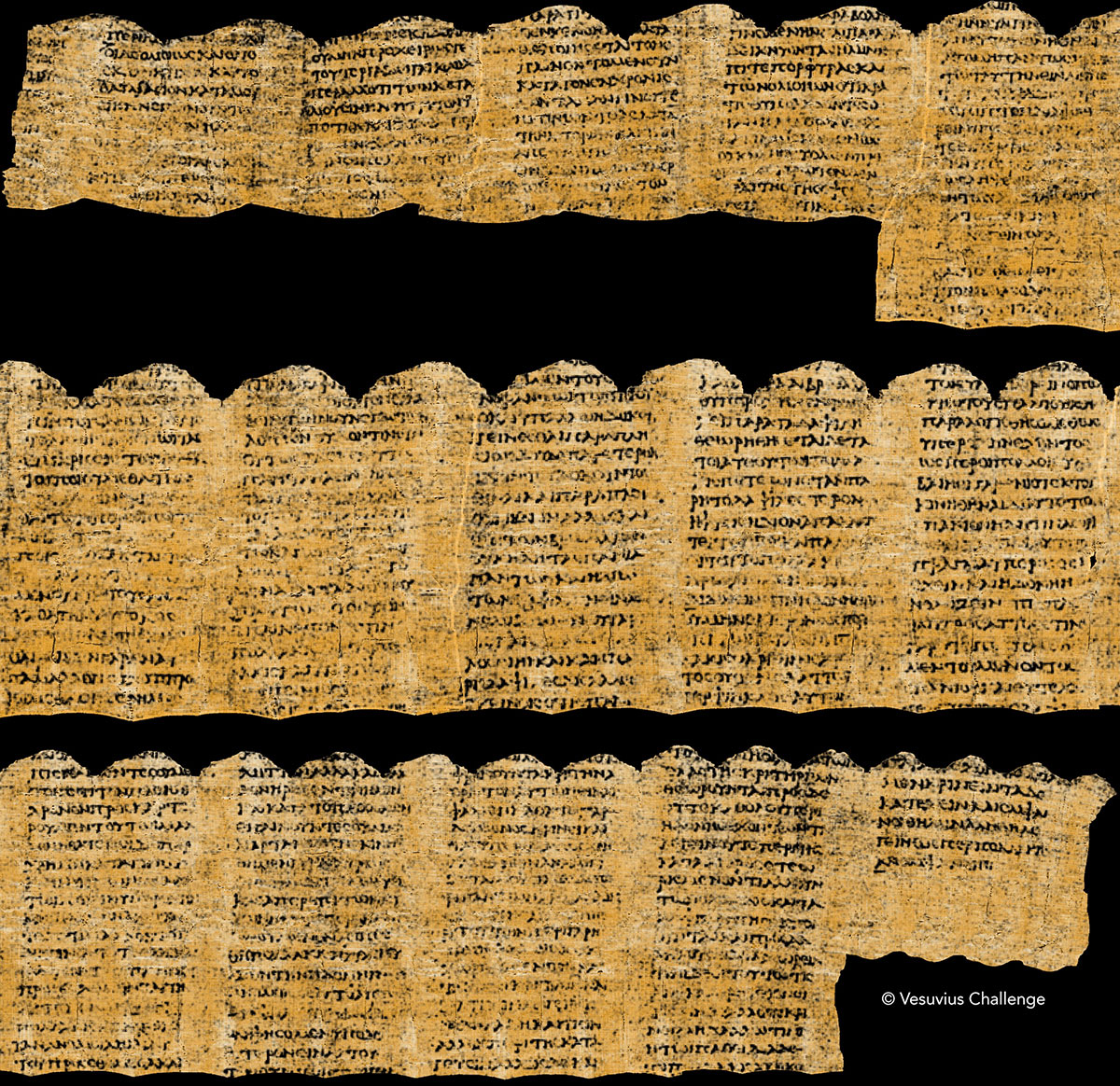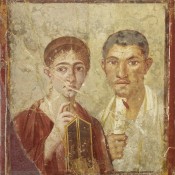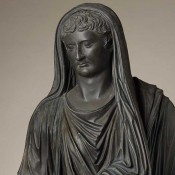Two thousand years ago, a volcanic eruption buried an ancient library of papyrus scrolls now known as the Herculaneum Papyri.
In the 18th century the scrolls were discovered. More than 800 of them are now stored in a library in Naples, Italy; these lumps of carbonized ash cannot be opened without severely damaging them. But how can we read them if they remain rolled up?
On March 15th, 2023, Nat Friedman, Daniel Gross, and Brent Seales launched the Vesuvius Challenge to answer this question. Scrolls from the Institut de France were imaged at the Diamond Light Source particle accelerator near Oxford. We released these high-resolution CT scans of the scrolls, and we offered more than $1M in prizes, put forward by many generous donors.
A global community of competitors and collaborators assembled to crack the problem with computer vision, machine learning, and hard work.
Less than a year later, in December 2023, they succeeded. Finally, after 275 years, we can begin to read the scrolls.
The thoughts of our ancestors, locked in mud and ash for 2000 years, hidden in darkness — now, with the light of a worldwide effort shining upon them, finally seen again.
Grand Prize
The Vesuvius Challenge organizing team received many excellent submissions for the Vesuvius Challenge Grand Prize, several in the final minutes before the midnight deadline on January 1st.
These submissions were presented to the review team, and they were met with widespread amazement. The month of January was spent by carefully reviewing all submissions. Ateam of eminent papyrologists worked day and night to review 15 columns of text in anonymized submissions, while the technical team audited and reproduced the submitted code and methods.
There was one submission that stood out clearly from the rest. Working independently, each member of the team of papyrologists recovered more text from this submission than any other. Remarkably, the entry achieved the criteria set when announcing the Vesuvius Challenge in March: 4 passages of 140 characters each, with at least 85% of characters recoverable. This was not a given: most of the people on the organizing team assigned a less than 30% probability of success when they announced these criteria! And in addition, the submission includes another 11 (!) columns of text — more than 2000 characters total.
The results of this review were clear and unanimous: the Vesuvius Challenge Grand Prize of $700,000 is awarded to a team of three for their excellent submission. Congratulations to Youssef Nader, Luke Farritor, and Julian Schilliger!
All three winning team members have been strong community contributors since the very beginning of the Vesuvius Challenge. You may remember Youssef. He is the Egyptian PhD student in Berlin who was able to read a few columns of text back in October, winning the second-place First Letters Prize. His results back then were particularly clear and readable, which made him the natural lead for the team that formed.
All three winning team members have been strong community contributors since the very beginning of the Vesuvius Challenge. You may remember Youssef. He is the Egyptian PhD student in Berlin who was able to read a few columns of text back in October, winning the second-place First Letters Prize. His results back then were particularly clear and readable, which made him the natural lead for the team that formed.
Luke is the 21-year-old college student and SpaceX intern from Nebraska, who was the first person in history to read an entire word from the inside of a Herculaneum scroll (ΠΟΡΦΥΡΑϹ, “purple”). This won him the first-place First Letters Prize, a few weeks before Youssef’s results.
Julian is the Swiss robotics student at ETH Zürich, who won three Segmentation Tooling prizes for his incredible work on Volume Cartographer. This enabled the 3d-mapping of the papyrus areas you see before you.
For the Grand Prize, they assembled into a superteam, crushing it by creating what was unanimously deemed the most readable submission.
The submission contains results from three different model architectures, each supporting the findings of the others, with the strongest images often coming from a TimeSformer-based model. Multiple measures prevent overfitting and hallucination, including results from multiple architectures, a study across input/output window sizes, label smoothing, and varying validation folds. This ink detection code has been made public as open source (on GitHub), leveling up everyone in the community.
In addition to unparalleled ink detection, the winning submission contained the strongest auto-segmentation approach the Vesuvius Challenge organizing team have seen to date (more about the process of “segmentation” below). ThaumatoAnakalyptor (roughly: Miracle Uncoverer) by Julian generates massive papyrus segments from multiple scrolls. Re-segmentations of well known areas validate previous ink findings, and entirely new segmentations reveal writing elsewhere, such as the outermost wrap of the scroll!
What does the scroll say?
To date, about 5% of the first scroll has been unrolled and read. The eminent team of papyrologists has been hard at work and has achieved a preliminary transcription of all the revealed columns. We now know that this scroll is not a duplicate of an existing work; it contains never-before-seen text from antiquity. The papyrology team are preparing to deliver a comprehensive study as soon as they can. Initial readings already provide glimpses into this philosophical text. According to scholars fo the project:
The general subject of the text is pleasure, which, properly understood, is the highest good in Epicurean philosophy. In these two snippets from two consecutive columns of the scroll, the author is concerned with whether and how the availability of goods, such as food, can affect the pleasure which they provide.
Do things that are available in lesser quantities afford more pleasure than those available in abundance? Our author thinks not: “as too in the case of food, we do not right away believe things that are scarce to be absolutely more pleasant than those which are abundant.” However, is it easier for us naturally to do without things that are plentiful? “Such questions will be considered frequently.”
Since this is the end of a scroll, this phrasing may suggest that more is coming in subsequent books of the same work. At the beginning of the first text, a certain Xenophantos is mentioned, perhaps the same man — presumably a musician — also mentioned by Philodemus in his work On Music.
Philodemus, of the Epicurean school, is thought to have been the philosopher-in-residence of the villa, working in the small library in which the scrolls were found.
For further reading: https://scrollprize.org/grandprize





